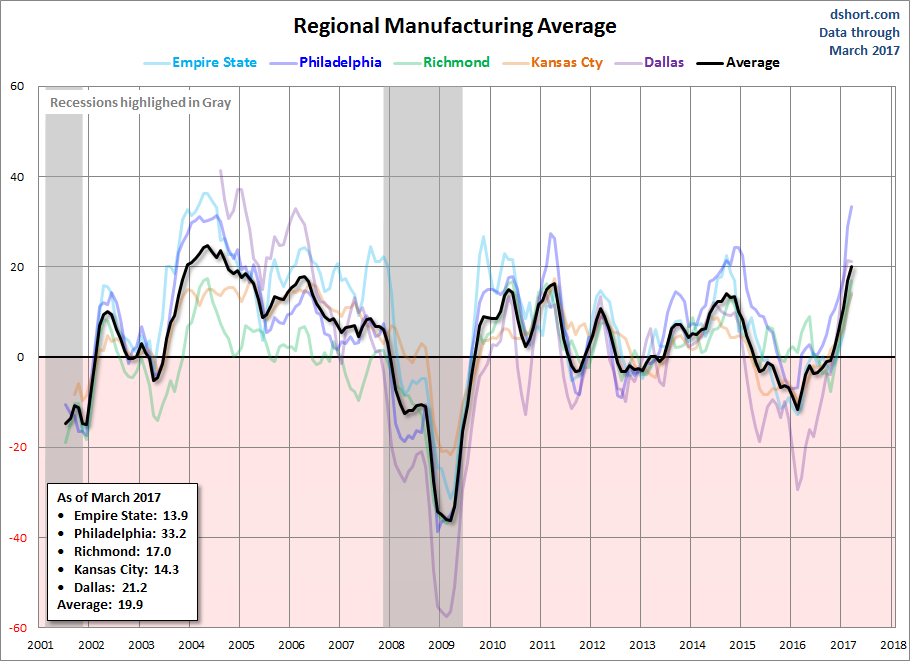Five out of the twelve Federal Reserve Regional Districts currently publish monthly data on regional manufacturing: Dallas, Kansas City, New York, Richmond, and Philadelphia.
Regional manufacturing surveys are a measure of local economic health and are used as a representative for the larger national manufacturing health. They have been used as a signal for business uncertainty and economic activity as a whole. Manufacturing makes up 12% of the country's GDP.
The other 6 Federal Reserve Districts do not publish manufacturing data. For these, the Federal Reserve’s Beige Book offers a short summary of each districts’ manufacturing health. The Chicago Fed published their Midwest Manufacturing Index from July 1996 through December of 2013. According to their website, "The Chicago Fed Midwest Manufacturing Index (CFMMI) is undergoing a process of data and methodology revision. In December 2013, the monthly release of the CFMMI was suspended pending the release of updated benchmark data from the U.S. Census Bureau and a period of model verification. Significant revisions in the history of the CFMMI are anticipated."
Here is a three-month moving average overlay of each of the five indicators since 2001 (for those with data). The latest average of the five for March is 19.9, up from last month's 16.8 and its highest since 2004.

Here is the same chart including the average of the five. Readers will notice the range in expansion and contraction between all regions.

For comparison, here is the latest ISM Manufacturing survey.

Here are links to the five monthly manufacturing indicators that we track:
- Texas Manufacturing Outlook Survey (TMOS)
- Kansas City Manufacturing Survey
- Empire State Manufacturing Survey
- Fifth District Manufacturing Survey (Richmond)
- Philadelphia Fed Manufacturing Business Outlook Survey
APPENDIX:
The twelve districts are as follows:
Boston (First Federal Reserve District) - Connecticut (excluding Fairfield County), Massachusetts, Maine, New Hampshire, Rhode Island and Vermont
New York (Second Federal Reserve District) – includes New York State, the 12 northern counties of New Jersey, Fairfield County in Connecticut, Puerto Rico, and the U.S. Virgin Islands.
Philadelphia (Third Federal Reserve District) – includes Eastern Pennsylvania, southern New Jersey, and Delaware
Cleveland (Fourth Federal Reserve District) - Ohio, western Pennsylvania, the northern panhandle of West Virginia, and eastern Kentucky; Fourth Federal Reserve District
Richmond (Fifth Federal Reserve District) – includes Ohio, western Pennsylvania, the northern panhandle of West Virginia, and eastern Kentucky
Atlanta (Sixth Federal Reserve) - Alabama, Florida, Georgia, and portions of Louisiana, Mississippi, and Tennessee; Sixth Federal Reserve District
Chicago (Seventh Federal Reserve District) - Iowa, and most of Illinois, Indiana, Michigan, and Wisconsin
St. Louis (Eighth Federal Reserve District) - most of eastern Missouri and southern Illinois
Minneapolis (Ninth Federal Reserve District) - Minnesota, Montana, North and South Dakota, 26 counties in northwestern Wisconsin and the Upper Peninsula of Michigan
Kansas City (Tenth Federal Reserve District) – includes Colorado, Kansas, Nebraska, Oklahoma, Wyoming, northern New Mexico, and Western Missouri
Dallas (Eleventh Federal Reserve District) - Texas, northern Louisiana, and southern New Mexico
San Francisco (Twelfth Federal Reserve District) - Alaska, Arizona, California, Hawaii, Idaho, Nevada, Oregon, Utah, Washington, Guam, American Samoa, and the Northern Mariana Islands
